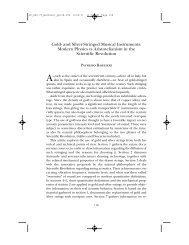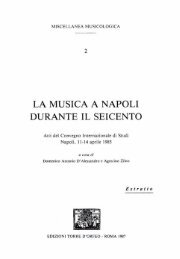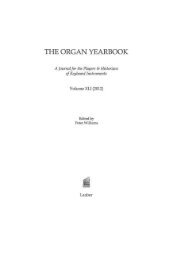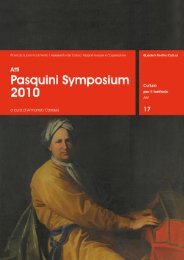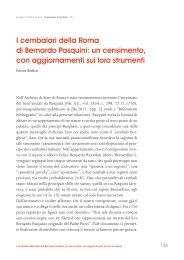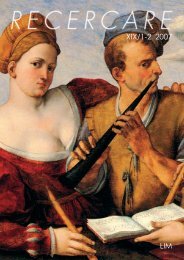prova carideo - Patrizio Barbieri
prova carideo - Patrizio Barbieri
prova carideo - Patrizio Barbieri
Create successful ePaper yourself
Turn your PDF publications into a flip-book with our unique Google optimized e-Paper software.
Subject Index<br />
Académie des sciences (France), 122, 124n, 358,<br />
378n, 533<br />
Academy of sciences (France): see Académie<br />
des sciences<br />
Accademia dei Lincei:see Lincei<br />
acoustic device for lutes and guitars, 234-5<br />
Almerie (Le Maire), 234, 300<br />
alphorn, 197<br />
Apollonicon (orchestra-organ by Robson &<br />
Son), 74n, 75, 75n<br />
Arabic comma, 97<br />
Archicembalo (Vicentino), 23, 27, 31, 32, 51,<br />
308-24, 313-6 (‘first tuning’), 316-9<br />
(‘second tuning’), 342, 458, 466n<br />
Archicetera (Doni), 252<br />
Arcimandora (Doni), 252<br />
Arciorgano (Vicentino), 28, 309-13, 342<br />
arpicordo, 239n, 313<br />
ars combinatoria, 339<br />
Aurelianum organum: see Diatonic Toniaion<br />
Bach J.S., and equal temperament, 297-8<br />
bassoon, intonation, 137<br />
beats: of tempered consonances, formula, 56n,<br />
57n; of the 5ths, 56, 217<br />
Calcutta (India), Scottish Presbyterian church:<br />
Liston’s enharmonic organ, 69, 70, 71<br />
cembalo ad arco: see geigenwerk<br />
cembalo cromatico, 17, 18, 21, 22n, 24, 27, 29,<br />
30, 38, 51, 140n, 242, 304, 305, 306, 307,<br />
319, 343, 405, 408, 412, 413-4 (Picerli’s<br />
instructions for tuning), 415, 417n<br />
(owned by Carlo Gesualdo)<br />
Cembalo onnicordo (Nigetti), 23n, 29, 51, 247,<br />
327, 333, 380, 441-505 (470: by Bolcioni)<br />
Cembalo panarmonico, type (by Doni): diarmonico,<br />
245-7; esarmonico (Della Valle),<br />
239-41, 243, 256; esarmonico (for King<br />
João IV of Portugal), 242-3; pentarmonico,<br />
23n, 462-3, 467, 479-87; triarmonico,<br />
228-30<br />
cent: definition, 114, 394n, 401n; origin, 285<br />
Cerberus: see Guitar, Triharmonic<br />
Changeable harpsichord, 57, 58, 59, 66<br />
chitarrone, triharmonic (Doni), 252<br />
Chordoelian: see harmonium<br />
chromatic genus: soft, 415-6, 417; tense, 415-6,<br />
418<br />
“chromatic” compositions (by Filago), 417<br />
church modes: transposition, 45-6<br />
circulation, 289n, 329, 421-2, 448-50. See also<br />
harmonic clock<br />
clarinet: intonation, 137<br />
Clavecymbalum universale: 51, 303-05 (Luython)<br />
Clavemusicum omnitonum, 26, 27, 327, 417n<br />
Clavichord, enharmonic: 518 (Gebel); 300 (Ruscelli);<br />
403-13 (Sambuca Lincea, by Colonna)<br />
clock, harmonic: see harmonic clock<br />
combinational tones, 91, 97n, 111, 111n<br />
comma, definition of: “artificial” (ETS 53), 350;<br />
Pythagorean, 9, 86, 97, 283n, 394n, 442n;<br />
septimal, 202n; syntonic, 6-7, 54n, 97,
612 Contents of the CD<br />
395n, 443n<br />
computer-assisted performance of enharmonic<br />
compositions, 49n<br />
concertina: English, 93, 170; German, 93<br />
consonance, degree of: 193-4 (Euler), 208, 208n<br />
(Barca, Euler, Riccati), 217 (Helmholtz),<br />
368, 368n (Riccati)<br />
continued fractions: binary, 355, 361 (ETS 53 by<br />
Euler, ETS 50 by Smith), 387-92; ternary,<br />
381-3<br />
cube root: arithmetical approximation (Riccati),<br />
392<br />
cyclic system (cyclical temperaments): see ETS<br />
diaschisma, ancient definitions, 284, 353. See also<br />
schisma<br />
diatonic genus, origin of term, 7<br />
Diatonic Hemiolon (Doni-Ptolemy’s “Diatonico<br />
equabile” for a viol consort), 180-81,<br />
197, 237-8<br />
Diatonic Toniaion (Caramuel-Marci’s keyboard,<br />
called “Aurelianum organum”), 185<br />
division, arithmetic vs. geometric: of the comma,<br />
387-91; of the tone, 349<br />
Double Diatonic Scale (Poole), 80n<br />
dulcimer, 286<br />
eleventh ‘harmonic’ (or ‘prime number’): 179-<br />
92; alphorn, 197; Choquel, 205n; Colonna,<br />
205n, 401; guitar (Partch), 74n; horn,<br />
195-6, 219; trumpet, 195-6; viol consort<br />
(Doni), 180-84<br />
enharmonic diesis: definition, 17-8, 55; on keyboard<br />
instruments, 22; on stringed instruments,<br />
141, 148<br />
enharmonic ‘of the Italians’, 49, 146, 272-4<br />
enharmonic genus: soft, 415-6, 418; tense, 415-<br />
6, 419<br />
‘enharmonic’ vs. ‘chromatic’ keyboards, 28-30<br />
enharmonique cromatique (Rameau), 146, 148<br />
enharmonique diatonique (Rameau), 149<br />
Enharmonium: see harmonium<br />
Enlightenment: septimal ratios, 192-216;<br />
eptameride, 377-8, 380, 381<br />
equal tempered system: see ETS<br />
ETS (Equal Tempered System): analysis and<br />
synthesis, 363-75; definition, 279-80;<br />
origin, 281; species: 5, 363, 365; 7, 285-<br />
7, 362, 363, 365; 12, 4, 9-10, 18, 45, 105,<br />
213, 287-98, 305; 17, 358; 18, 105, 105n;<br />
19, 5, 33, 213, 282n, 303-07, 358; 22,<br />
373; 24, 5, 33, 105, 105n, 234, 298-301,<br />
515, 518; 25, 373, 386; 26, 302, 357; 28,<br />
362, 363, 386; 30, 105; 31, 5, 27, 33, 41,<br />
96n, 123, 247, 282n, 308-41, 393-440,<br />
447 (notation); 33, 357, 373; 34, 381,<br />
386; 36, 105; 38, 357; 41, 369; 43, 282,<br />
345, 357, 358 (Sauveur); 45, 282, 345,<br />
357; 48, 105, 105n, 302-03; 50, 357, 358<br />
(Henfling), 378; 52, 302 ; 53, 75, 79n,<br />
96n, 97, 97n, 98, 102, 104n, 302, 350-51;<br />
55, 127, 345-9, 357, 358, 381; 56, 373n;<br />
57, 357; 59, 362, 363; 60, 343; 62, 341-4,<br />
357; 64, 343 ; 67, 357, 369; 69, 357,<br />
362n, 366; 72, 105, 284, 350n, 361n; 74,<br />
216, 357, 366, 368 (Riccati), 377; 79,<br />
369; 81, 357, 359, 366; 86, 357; 87, 362,<br />
363, 373, 381, 386; 93, 357; 96, 105,<br />
105n, 302-03, 354; 98, 357; 105, 354,<br />
357; 110, 357; 112, 358, 369; 117, 357;<br />
118, 369, 372, 375, 381, 386; 122, 357;<br />
129, 357; 136, 351-4, 358, 377; 141, 357;<br />
143, 369; 144, 5, 105, 283; 153, 357; 160,<br />
358; 165, 357; 171, 369, 372, 375; 174,<br />
369, 372, 374; 177, 357; 184, 358; 189,<br />
357; 200, 369, 372; 205, 362, 374; 208,<br />
358; 215, 378; 217, 378, 379 (Becattelli),<br />
382-3, 446n; 232, 358; 256, 358; 277,<br />
382-3; 289, 375; 301, 358, 377; 306, 97n,<br />
375; 460, 375; 525, 375; 559, 386; 573,<br />
383; 612, 67n, 383-7; 643, 375; 665, 375;<br />
789, 374; 810, 378n; 817, 386; 1266,<br />
375; 1342, 382<br />
Euharmonic Organ (Liston), 69<br />
exponential notation, definition, 11-2, 54-5, 108-<br />
09<br />
expressive intonation: see Pythagorean intonation<br />
fingering: keyboard instruments based on ETS<br />
31, 410-13, 456-8, 464; Orazi’s flute,<br />
513-4<br />
flute: bass, 512n, 528-30; Bosa, 516; Diatonic<br />
(by Siccama), 517; enharmonic (Orazi),<br />
512-7; enharmonic music (Delusse,<br />
Orazi), 519-28; intonation, 139, 162, 169<br />
(with split keys, designed by W.J. Monzani);<br />
Koch, 516; Laurent, 517; ottavino<br />
(piccolo), 528; Panaulon (by Trexler),<br />
516; Potter, 169; sestino, 528; tenore,<br />
528; terzino, 528. See also “tempera-
Subject Index 613<br />
ment” and “fingering”<br />
frequency difference limen, 4<br />
frets: positioning, 39-45; Bresciani’s testimony,<br />
452-4; Doni’s ETS 24 on his Lyra Barberina,<br />
300; Espina’s ETS 19 (?) on fretted<br />
instruments, 43; Le Blanc on the basse de<br />
viole, 117; Le Maire’s ETS 24 on the<br />
lute, 300; Lusitano on enharmonic frets,<br />
47; Salvetti (see Lirone enarmonco);<br />
Trew’s ETS 24 on the lute; Vicentino’s<br />
ETS 31 on the lute, 41-3; Vicentino on<br />
the usual fretting of the lute, 316n. See also<br />
tastini<br />
functional-expressive intonation: see Pythagorean<br />
intonation<br />
geigenwerk, 294n<br />
general tempered systems, 363n. See ETS<br />
geometric temperaments, 363. See ETS<br />
golden section, 44-5<br />
‘Gothic’ tuning: see Pythagorean intonation<br />
Gradus suavitatis (Euler), 193-4. See also consonance<br />
‘Greek’ instruments (16th-17th centuries), 260-<br />
62<br />
Greek modes, harmoniai, octave species, and<br />
tonoi: chap. E, passim;<br />
guitar: acoustic device, 234-5; enharmonic<br />
(Partch), 74n; enharmonic (Thompson),<br />
72-4; enharmonic (Vogel), 74n; ‘Spanish’<br />
(baroque), 287, 289n; Triharmonic<br />
(Doni), 250-53, 260;<br />
guitar-zither, 260<br />
hackebort, 286<br />
Harmon: see harmonium<br />
harmonic clock (wheel), 289n (Poglietti’s<br />
Horologium musicale, ETS 12), 347<br />
(Blankenburg, ETS 31), 345 (Fernandes,<br />
ETS 55), 346 (Warren, ETS 31)<br />
harmonics (partials): problems of intonation,<br />
197-8<br />
Harmonie parfaite, L’– (Roser and Könnicke),<br />
463-6<br />
harmonium, enharmonic: Alley, 80-82; Blaserna,<br />
87n; Brown (Voice –), 83-7; Busoni,<br />
105n; Eitz, 96; Guéroult, 91-2; Helmholtz,<br />
78, 91-2; McClure, 66; Meyer,<br />
105n; Saunders (Mesotonic – or Tilting<br />
action –), 66, 66n; Snell (Chordoelian, a<br />
kind of ‘seraphine’), 82-3; Steiner, 86-7;<br />
Tanaka (Enharmonium), 87; White (Harmon),<br />
100-02<br />
harp: arpa Barberini, 437n; Cousineau (Pytha -<br />
gorean tuning), 87; equally tempered,<br />
289; three-rank, 435-7; Triharmonic<br />
(Doni), 253, 253n; pedals, 61<br />
harpsichord, enharmonic and/or transposing:<br />
Ban, 36; Clagget (see Royal Teliochordon<br />
stop); Domenichino, 437-8; Doni<br />
(see Cembalo panarmonico); Gallé, 305;<br />
Huygens, 332; Luython (see Clavecymbalum<br />
universale); Nigetti (see Cembalo<br />
onnicordo); Ramerino, 351, 467; Sabbatini,<br />
34; Roussier, 87-8; Salinas, 33;<br />
Salzinger’s Tastatura nova perfecta, 337-<br />
40; Sarti, 356n; Smith’s Changeable –,<br />
56-9; Stella’s Tricembalo, 403-13; Stembridge,<br />
38; Titelouze, 305-06; Trasuntino<br />
(see Clavemusicum omnitonum); Trasuntino,<br />
25; Valentini, 39; Vicentino (see<br />
Archicembalo); von Wiese, 88-91; Zarlino,<br />
24. See also cembalo cromatico<br />
helicon, 191n, 397-9<br />
heptameride: see eptameride<br />
horn, 195-6 (seventh and eleventh partials)<br />
Industrial Revolution, 103<br />
inharmonicity: see strings<br />
just intonation: definition, 11-2; commatic shift,<br />
13-4, 80; ‘expanded’, 219; fretted instruments,<br />
39, 72-4 (Thompson’s enharmonic<br />
guitar); harpsichord (Ban, 36; Doni,<br />
228-9; Roussier, 87-8; Sabbatini, 34;<br />
Salinas, 33; Stembridge, 38; Valentini,<br />
39; von Wiese, 88-91; Zarlino, 30); “harmonic<br />
temperament” (Euler), 211-2; harmonium<br />
(Alley, 81-3; Blaserna, 87n;<br />
Brown, 83-7; Eitz, 96; Guéroult, 91-2;<br />
Helmholtz, 91-2; Steiner, 86-7; Tanaka’s<br />
Enharmonium, 87); organ (Alley &<br />
Poole, 78-82; Bosanquet, 92-6; Liston,<br />
68-72; Thompson, 74-8); piano (San -<br />
chez), 88; Riccati’s symmetrical scale,<br />
193, 212-6; singers, 16, 79-80 (see also<br />
movable Do); viol consort (Doni), 230;<br />
violin, 108-23. See also scale<br />
keyboard, symmetrical: Alley, 82; Bosanquet’s<br />
“Generalized keyboard”, 94-5; Brown’s<br />
“Natural Finger-board”, 83-7; Caramuel,<br />
96n, 290; Eitz, 96; Henfling, 291, 339;
614 Subject Index<br />
Poole, 81, 82; Sachs, 292; Salzinger, 339-<br />
40; Sanchez, 88; Secor, 96n; Wilson, 96n<br />
keys (tonalities): expressive qualities (Riccati),<br />
206-09; E-flat major, preferred by the<br />
Italians, 208-09; those practiced, 115;<br />
limbic system, 4<br />
Lincei, Accademia dei, 254, 396, 424, 425, 426n,<br />
427, 428<br />
Lirone enarmonico (Salvetti), 41, 42<br />
logarithms (in music): 282-5 (unit of measure);<br />
282 (Cavalieri’s pioneer use); 332n (precision,<br />
in the 17th century). See also cent<br />
lute: ‘chromatic’, 41. See also frets<br />
Lyra Barberina, 49, 230, 231-5, 250, 250n, 300<br />
lyra-cyster, 260, 261<br />
lyre, 344<br />
maniera smorfiosa: bowed instrument players,<br />
152-7; singers, 157<br />
marine trumpet, 199n<br />
meantone intonation, definition, 123, 443<br />
Mercator’s comma, 97. See also Arabic comma<br />
meride, 356, 377-8<br />
mesolabium, 95n<br />
microtonal compositions: 139-52; 319-24 (Vicentino);<br />
418-9 (Maione)<br />
‘movable Do’ (Tonic Sol-Fa Association), 78,<br />
80, 83, 103<br />
musical circle (circulating composition), origin,<br />
289n. See also harmonic clock<br />
natural philosophers, 186-92<br />
negative system: definition, 93<br />
neural spikes, 14<br />
notation, musical: different types for ETS 31,<br />
447. See also exponential notation<br />
oboe: intonation, 137<br />
orchestra, intonation, 156, 173-6<br />
Orchestrion (orchestra-organ by Vogler), 75n<br />
organ: compound stops vs. equal temperament,<br />
69, 69n, 288-9, 296-8; enharmonic (Alley<br />
& Poole’s Euharmonic –, 79; Bosanquet,<br />
92-6; Doni’s Triharmonic, 253-5; Fickenscher’s<br />
Polytone, 79n; Hawkes, 61-2;<br />
Liston’s Euharmonic –, 68-72; Salzinger,<br />
338-9; Thompson, 74-8, 517; Vogel,<br />
372); “suono gargante” stop (Colonna<br />
and Della Porta), 425, 426; reservoirs,<br />
stabilization of the pressure, 68n; tremulant<br />
stop, 425; why equally tuned, 75<br />
Organum panarchicum (Caramuel), 290, 458<br />
Pentecontachordon (Colonna), 404. See Sambuca<br />
Lincea<br />
Pentorgano (Stella), 327, 429<br />
perfect number, definition, 186n<br />
Phonometer (tuning monochord by Thompson),<br />
76<br />
piano: enharmonic (Hawkes, 62; Loeschman,<br />
62-6; Roser & Könnicke’s Harmonie parfaite,<br />
463-6; Sanchez, 88); equally tuned<br />
when playing with orchestras, 176; with<br />
split keys, 59, 59n, 88-9<br />
pitch: Great Britain, 69n; Rome, 259<br />
Polytone (Fickenscher), 79n<br />
portamento, 46, 151, 157, 299 (“strascini”), 415<br />
and 419 (“strisciate di voce”), 518-9 (on<br />
the flute and violin)<br />
positive system: definition, 92, 302, 358<br />
positivistic mentality in music, 103<br />
Proteo (Nigetti), 327, 328, 441, 469, 472, 473.<br />
See also Cembalo onnicordo<br />
Pythagorean intonation: definition, 8-9, 11; enharmonic<br />
keyboard instruments on<br />
Pythagorean and just intonation reconciled,<br />
87-96; functional-expressive, 157-<br />
72; ‘Gothic’ type, 20, 21; on common<br />
keyboard instruments, 19; on<br />
Cousineau’s harp, 87;<br />
quarter-comma tuning: see meantone intonation<br />
Quid non ebrietas? (Willaert), 283n<br />
recorder: intonation, 137-9<br />
residuals, theory of (Colonna), 396-403<br />
Royal Society (London), 176, 191, 328, 350,<br />
362n, 386, 386n, 477<br />
Royal Teliochordon stop, 61<br />
sambuca, definition, 404n<br />
Sambuca Lincea (Colonna), 306, 327, 393-440<br />
scale: diatonic, 7; equal-tempered, 9-10 (ETS<br />
12); heptatonic, 7-8; origin, 3-5; pentatonic,<br />
5-7, 185; symmetrical: 212-6 (Riccati),<br />
214 (Boisgelou, Blein, Opelt);<br />
whole tone, 10<br />
schisma: ancient definition, 284, 353; modern<br />
definition, 67n, 86; as a unit of measure,<br />
67n, 384-6
Subject Index 615<br />
Scientific Revolution, 5, 186-92<br />
sector, 330, 331<br />
semitone, chromatic: definition, 8-9<br />
semitone, diatonic: definition, 7-8<br />
Senario number: definition, 179; problems, 192<br />
septimal comma vs. septimal diesis, 202n<br />
septimal ratios: see seventh harmonic<br />
seraphine: see harmonium<br />
seventh ‘harmonic’ (or ‘prime number’): chap.<br />
D, passim; Colonna, 401; cornet, 219; enharmonic<br />
intervals with the Senario,<br />
200ff.; guitar (Partch, Vogel), 74n; horn,<br />
195-6, 219; keyboard non-enharmonic<br />
instruments, 203-10; marine trumpet,<br />
199n; Neapolitan 6th, 201; organ (Allen<br />
& Poole), 79; organ stops, 194-5, 194n,<br />
195n, 217, 217n; piano, 217; trumpet,<br />
195-6, 219; violin, 165, 196-202. See also<br />
singers<br />
sevenths: Pythagorean, syntonic, ‘septimal’ (definition),<br />
206; ‘septimal’ (harmonic), 79,<br />
80, 81; syntonic (vs. ‘septimal’), 80<br />
sharps and flats mixed vertically, 146, 146n<br />
singers: enharmonic microtones in performing<br />
practice, 142-4, 150-52; seventh harmonic,<br />
202-03. See also “portamento”, and<br />
“maniera smorfiosa”<br />
sistema partecipato: definition, 443; origin, 15<br />
slides (ornamentation): see portamento<br />
sordino (sordina), 476, 476n<br />
split keys, 17ff; on pianos, 59, 59n; on organs,<br />
partially eliminated, 469; origin, 19-21<br />
square root, arithmetical approximation (Riccati),<br />
391<br />
stile misto vs. semplice, 49, 49n<br />
strings: gut, “Roman”, 72n; inharmonicity, 40,<br />
74; silk, 248n<br />
stylus metabolicus, 49, 52, 269-72<br />
subjective scale of pitch, 4<br />
superparticular ratio, definition, 180n<br />
syntonic intonation: see just intonation<br />
Tastatura nova perfecta (Salzinger), 337-41<br />
Tastatura quinqueformis (Bulyowsky), 333-7<br />
tastini, on the viola da gamba, 40, 51<br />
Telemann’s systema intervallorum (= ETS 55),<br />
127<br />
temperament: equal, on bassoon, 137n; equal, on<br />
flute, 139, 162; equal, on fretted instruments,<br />
44-5; equal, on harp, 289; equal,<br />
problems on organ: see organ; equal, on<br />
piano, 103n; mean-semitone type, 175-6;<br />
meantone-type, on fretted instruments,<br />
39; meantone-type, regular, m/n-comma:<br />
1/3, 15, 32n, 41, 375 (correspondence<br />
with ETS 19); 2/7, 15, 16, 32n, 213, 358,<br />
360; 7/24, 362n (correspondence with<br />
ETS 69); 5/18 (Smith’s “Equal harmony”),<br />
58, 361 (correspondence with ETS<br />
50), 362n; 1/4, 14-5, 18, 27, 32, 204-5,<br />
296, 330-31 (correspondence with ETS<br />
31, by Rossi), 352, 408, 416n, 446n;<br />
1/4.151 (= ETS 31), 27, 364; 2/9, 353;<br />
3/14, 364 (correspondence with ETS 74);<br />
1/5, 204, 210, 358, 379, 381, 446, 446n<br />
(Cristofori); 3/17, 346-7, 364 (correspondence<br />
with ETS 55); 1/6 (of Mercator’s<br />
comma), 62, 62n; 1/6, 18, 347, 358, 360<br />
(approximate correspondence with ETS<br />
55), 446; meantone-type, irregular (circulating):<br />
Riccati, 204; Vogt, 298. See also<br />
ETS<br />
temperament, regular: definition, 280n<br />
tetrachord, 27n, 191n, 281n, 330, 332, 384, 384n,<br />
397<br />
Terpodion, 63n<br />
Tetractys, 179<br />
theorbo: triharmonic (Doni), 251-3<br />
theory of numbers: Farey’s theorem, 366n<br />
third, major, definition: just, 11, 55, 108;<br />
Pythagorean, 7, 11, 55, 108; semiaugmented<br />
(redundant, septimal), 203, 206<br />
third, minor, definition: just, 11, 55, 108;<br />
Pythagorean, 6, 11, 55, 108; semidiminished<br />
(deficient, septimal), 203, 206<br />
third, ‘neutral’, 49, 180-81, 184, 228, 230, 237,<br />
238, 321 (Vicentino’s “propinque” minor<br />
3rds)<br />
‘third sound’, 111, 111n<br />
thirteenth harmonic: horn and trumpet, 196<br />
tiorbino, 239n<br />
tone: definition of ‘major’ and ‘minor’, 12, 56,<br />
109; effects of commatic shift, 55, 80;<br />
mean tone, 56<br />
tone: Aristoxenic divisions, 281, 302, 402; division<br />
into 9 commas, 47, 48, 346, 349; division<br />
into 10 commas, 341-4<br />
transpositions: Bresciani’s rule (“tavoletta”),<br />
450-53, 471, 475
616 Subject Index<br />
Tricembalo (Stella), 327, 403-13, 429<br />
Triharmonic harpsichord: see Cembalo panarmonico<br />
trumpet: ‘quality factor’ of ancient instruments<br />
(Q factor), 196; seventh harmonic, 195,<br />
195n (Handel’s Judas Maccabäus)<br />
tuning-fork: “differential” (Natali), 165; early-<br />
19th-century Britain, 69n<br />
tuning lattice: historical origin (Euler), 12<br />
undecimal ratios: see eleventh harmonic<br />
vibrato, 177<br />
viola da gamba: tastini, 40; fret positioning, 117<br />
viol consort: in just intonation (Doni), 230;<br />
‘Ptolemaic’ tuning (Doni), 180-84, 237-<br />
8; Viola diarmonica (Doni), 40, 230<br />
violin family: enharmonic microtones in compositional<br />
practice, 139-52; 5ths mistuned<br />
by a comma in usual performance, 114;<br />
diharmonic violin and viola (Doni), 40,<br />
230-31, 247-50; fingerings, 134-7; intonation,<br />
chap. C, passim (see also functional-expressive<br />
intonation); just vs.<br />
Pythagorean intonation, 169-72; open<br />
strings, 112, 113, 124-30, 133-4; violin<br />
vs. flute, 512-4, 518-9<br />
Violone panarmonico (Doni), 41, 243-5, 256,<br />
258<br />
Voice harmonium (Brown): see harmonium<br />
wheel, harmonic: see harmonic clock<br />
woodwinds: fingering and intonation, 137-9<br />
zoorgan, 549-52




